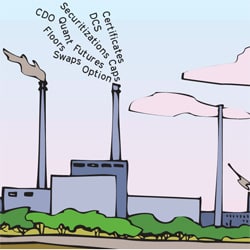Though many financial-services professionals may be expanding their positions in the derivatives market in search of capital appreciationespecially when traditional investments such as stocks and bonds are generating lackluster returns, at bestcorporate participants are primarily active in derivatives for these kinds of hedging purposes. Among the current favorites are credit derivatives. They provide a hedge in case one of your close business partnersa supplier or customer, typicallyfalls on bad times. If your biggest client is IBM, and youre afraid IBM is going to slip on a banana peel, you might get coverage based on IBMs creditworthiness, says Andrea Kramer, head of the financial products, trading and derivatives group at Chicago-based law firm McDermott Will & Emery.
To purchase credit or other types of derivatives, companies can turn to any reputable financial-services provider. Many large corporations, however, handle derivatives transactions in-house. In either case, they should start by reviewing corporate policies and procedures in detail. What has the board of directors actually authorized? Investing in derivatives for speculationthat is, to shore up sagging earnings or fill a hole on the balance sheetis generally considered a dangerous game, but hedging against future problems is not only acceptable, but often imperative.
Finance-savvy lawyers should be consulted to help negotiate and review all trading contracts under consideration. These documents lay out terms and expectations, and they take into account innumerable scenarios that could emerge. There may be regulatory issues to consider, too, depending on the industry, the type of derivative and the location. For insurance companies, for example, its necessary to consult state insurance regulators in both the home state and any states where the company does business, says Kramer.
Besides a legal opinion, accounting and tax expertise and, of course, trading capabilities, companies considering using derivatives also need a credit-risk evaluation. Again, this can be handled in-house or outsourced. Before you enter into contracts with other parties, its important to assess the risk youll be taking on. Are the other parties trustworthy? Whats their creditworthiness? explains Kramer.
Companies with a long-standing relationship with a bank often let the bank handle the whole operation. While that is understandable, it can be a mistake. Derivative products tend to be so complex that they require very sophisticated professionals to oversee them. Unless a company has the necessary in-house expertise, it would be well advised to seek help from a firm that is part of the International Swaps and Derivatives Association (ISDA), an independent trade group.
Its also a good idea to shop around when seeking outside help. Fees can vary widely and are not always obvious upfront. Typically, the fees are embedded in the purchase, cautions Kramer. Theyre buried in the bid-ask spread, so often you dont know what youre paying.
Despite these dangers, a growing body of regulations aims to make derivatives safer than ever. Theyre being accepted as a normal part of financing, as natural hedging devices, says Ellen Clark, a derivatives and structured-finance attorney at DLA Piper Rudnick Gray Cary in New York. Theyre not considered alternative investments any more. She cites a change in accounting rules that requires derivatives to be listed on the balance sheet, for more open disclosure. This is true even for some of the newer forms of derivatives, such as those based on underlying real estate transactions. They simply fill the real estate allocation in the companys portfolio, Clark says.
While regulatory agencies continue to encourage caution among investors, Clark points to one recent development that should give derivatives-holders some comfort. Last years Bankruptcy Reform Act, which made it harder for individuals to declare insolvency, included a provision that ensures speedy resolution of derivatives and other financial contracts in the event of a bankruptcy. There is now some legal certainty about how derivative products are unwound if there is a bankruptcy, asserts Clark. You can now immediately terminate and settle without having to go through a lengthy bankruptcy court process. This removes a degree of uncertainty and frees the market to have more fluid
liquidity. Its a big milestone.

|
|
Venkat:Interest-rat
-e and commodity
derivatives likely to grow more slowly
|
Other experts sound a more cautious note. These products can get so complex, even people who think they understand them can be taken by surprise, says John Lovi, a derivatives litigator with Steptoe & Johnson in New York. Theres bound to be some big blowup in the futurea couple of major disruptions or even a full-blown crisis. Wall Street, he says, is desperately trying to sell credit derivatives to corporate clients, hoping to seize an opportunity. Theres not yet a level of sophistication on the corporate side equal to that on Wall Street, Lovi contends. Companies have done a lot to become more sophisticated about credit derivatives, but there are still many who underestimate the risks. Thats one reason Im a busy guy as a litigator.
Lovi urges companies to establish a network of checks and balances. Derivatives can be so difficult to understand that theyre effectively unmanageable by any one person. A companys star derivatives person shouldnt be the one engaging in them, or you could run into major problems, he warns. There needs to be oversight by knowledgeable








